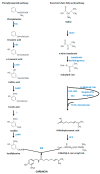Capsaicin: From Plants to a Cancer-Suppressing Agent
- PMID: 27472308
- PMCID: PMC6274000
- DOI: 10.3390/molecules21080931
Capsaicin: From Plants to a Cancer-Suppressing Agent
Abstract
Capsaicinoids are plant secondary metabolites, capsaicin being the principal responsible for the pungency of chili peppers. It is biosynthesized through two pathways involved in phenylpropanoid and fatty acid metabolism. Plant capsaicin concentration is mainly affected by genetic, environmental and crop management factors. However, its synthesis can be enhanced by the use of elicitors. Capsaicin is employed as food additive and in pharmaceutical applications. Additionally, it has been found that capsaicin can act as a cancer preventive agent and shows wide applications against various types of cancer. This review is an approach in contextualizing the use of controlled stress on the plant to increase the content of capsaicin, highlighting its synthesis and its potential use as anticancer agent.
Keywords: apoptosis; cancer; capsaicin; cell death; elicitors; stress.
Conflict of interest statement
The authors declare no conflict of interest.
Figures



Similar articles
-
Capsaicin accumulation in Capsicum spp. suspension cultures.Methods Mol Biol. 2006;318:327-34. doi: 10.1385/1-59259-959-1:327. Methods Mol Biol. 2006. PMID: 16673927
-
Peppers: A "Hot" Natural Source for Antitumor Compounds.Molecules. 2021 Mar 10;26(6):1521. doi: 10.3390/molecules26061521. Molecules. 2021. PMID: 33802144 Free PMC article. Review.
-
Molecular biology of capsaicinoid biosynthesis in chili pepper (Capsicum spp.).Plant Cell Rep. 2011 May;30(5):695-706. doi: 10.1007/s00299-010-0968-8. Epub 2010 Dec 14. Plant Cell Rep. 2011. PMID: 21161234 Review.
-
Biochemistry and molecular biology of capsaicinoid biosynthesis: recent advances and perspectives.Plant Cell Rep. 2019 Sep;38(9):1017-1030. doi: 10.1007/s00299-019-02406-0. Epub 2019 Apr 2. Plant Cell Rep. 2019. PMID: 30941502 Review.
-
Potent production of capsaicinoids and capsinoids by Capsicum peppers.J Agric Food Chem. 2013 Nov 20;61(46):11127-32. doi: 10.1021/jf403553w. Epub 2013 Nov 6. J Agric Food Chem. 2013. PMID: 24147886
Cited by
-
The Effects of Capsinoids and Fermented Red Pepper Paste Supplementation on Lipid Profile: A Systematic Review and Meta-Analysis of Randomized Controlled Trials.Clin Nutr Res. 2022 Oct 24;11(4):302-315. doi: 10.7762/cnr.2022.11.4.302. eCollection 2022 Oct. Clin Nutr Res. 2022. PMID: 36381475 Free PMC article.
-
Capsaicin: Emerging Pharmacological and Therapeutic Insights.Curr Issues Mol Biol. 2024 Jul 24;46(8):7895-7943. doi: 10.3390/cimb46080468. Curr Issues Mol Biol. 2024. PMID: 39194685 Free PMC article. Review.
-
Capsaicin exerts synergistic pro-apoptotic effects with cisplatin in TSCC through the calpain pathway via TRPV1.J Cancer. 2024 Jul 9;15(15):4801-4817. doi: 10.7150/jca.98075. eCollection 2024. J Cancer. 2024. PMID: 39132151 Free PMC article.
-
Exploiting the Anti-Inflammatory Potential of White Capsicum Extract by the Nanoformulation in Phospholipid Vesicles.Antioxidants (Basel). 2021 Oct 25;10(11):1683. doi: 10.3390/antiox10111683. Antioxidants (Basel). 2021. PMID: 34829554 Free PMC article.
-
Nonpungent N-AVAM Capsaicin Analogues and Cancer Therapy.J Med Chem. 2021 Feb 11;64(3):1346-1361. doi: 10.1021/acs.jmedchem.0c01679. Epub 2021 Jan 28. J Med Chem. 2021. PMID: 33508189 Free PMC article.
References
-
- Govindarajan V.S., Sathyanarayana M.N. Capsicum-production, technology, chemistry, and quality. Part V. Impact on Physiology, Pharmacology, Nutrition, and Metabolism; Structure, Pungency, Pain, and Desensitization Sequences. Crit. Rev. Food Sci. Nutr. 1991;29:435–473. doi: 10.1080/10408399109527536. - DOI - PubMed
Publication types
MeSH terms
Substances
LinkOut - more resources
Full Text Sources
Other Literature Sources

